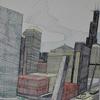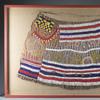Vicariously visit Tibet’s rarely-seen sacred sites in Rubin Museum exhibition this fall
- NEW YORK, New York
- /
- August 25, 2016
In New York this fall, Rubin Museum of Art visitors will experience Tibet’s most renowned architectural sites through historical and contemporary eyes in the exhibition “Monumental Lhasa: Fortress, Palace, Temple.” Images of monuments and sacred sites like the Statue of Liberty, Eiffel Tower, and Taj Mahal act as powerful representations of place, and “Monumental Lhasa” is the first exhibition to explore this kind of visual representation in Tibet, featuring drawings, paintings, and photographs of landmarks created primarily by Tibetans and Westerners since the 18th century.
Bringing together over 50 works of art from the Rubin Museum collection as well as public and private collections across Europe and North America, the exhibition revives one of the original functions of these images—to transmit the holy city of Lhasa to a remote audience. Spanning art that ranges from pilgrimage maps to photo albums, the exhibition explores how images contribute to the iconic character, familiarity, and power of important landmarks.
“Architecture is deeply connected to our impression and experience of places. While we may never visit these sites ourselves, we often become acquainted with them through encounters with images on postcards, souvenirs, and various forms of media,” exhibition curator Natasha Kimmet said. “In Lhasa, Buddhist pilgrims and other visitors created images focused on the capital’s striking landmark buildings to recreate and convey their experience of this important religious and political center of Asia.”
The exhibition introduces visitors to the monumental palace-fortresses, sacred temples, and powerful monastic institutions that anchored the religious and political life of Lhasa, including the Potala Palace, Jokhang Temple, and Samye monastery. Rare visual representations of Lhasa demonstrate the appeal of these monuments, as well as how cross-cultural encounters shaped the production of images. While the Tibetan images are shaped by Buddhist religious and historical narratives, Western and other foreign visitors were focused on imperial exploration, travel, and scientific discovery, highlighting how architecture images have often been manipulated to convey the messages of patrons and artists. Tibetans and foreigners frequently adjusted their representations of Lhasa’s buildings and geography to convey specific motives or perspectives—a practice that continues today through the use of photo editing tools and filters like Photoshop and photo apps for social media.
By collectively displaying these images, the Rubin invites visitors to vicariously traverse the key sites of central Tibet and to look closely at how architecture, geography, and the identity of Tibet have been represented and shared in ways that intersect with how we travel and experience places now.
Visitors can further engage with these ideas by peering into custom View-masters installed in the gallery that contain a variety of images representing Tibetan sites throughout history, from 17th century paintings to contemporary photos shared on social media.
Public programs and interpretive content will complement the exhibition, including an audio tour that features excerpts from Western travelogues and Tibetan pilgrimage guides. Additional programs will include a talk by Clare Harris, Professor of Visual Anthropology at the University of Oxford and Curator for Asian Collections at the Pitt Rivers Museum, tied to the launch of her latest book Photography and Tibet (Reaktion Books, 2016).

270x400_c.jpg)



10270x400_c.jpg)
















